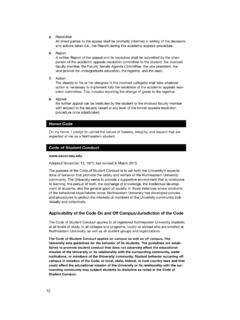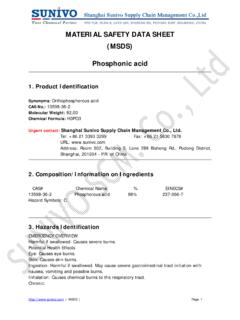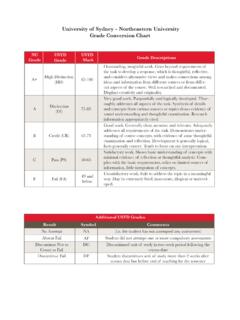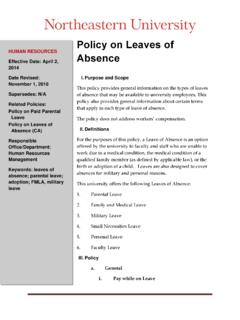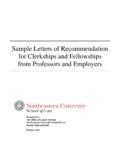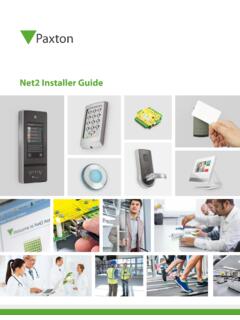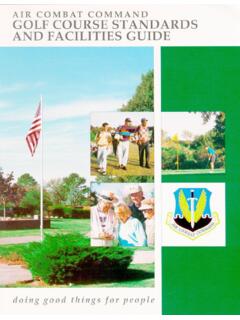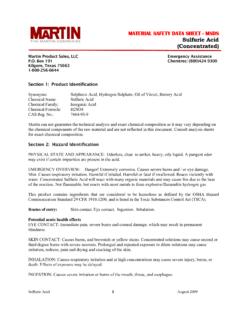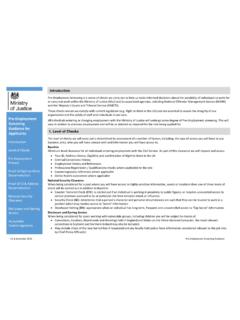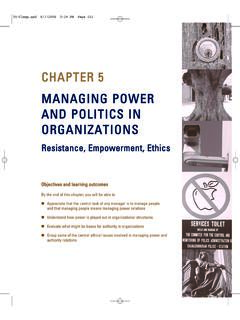Transcription of Sulfuric Acid - MSDS - Northeastern University
1 Sulfuric acid 1 August 2009 MATERIAL SAFETY DATA SHEET - MSDS Sulfuric acid (Concentrated) Martin Product Sales, LLC Emergency Assistance Box 191 Chemtrec: (800)424-9300 Kilgore, Texas 75663 1-800-256-6644 Section 1: Product Identification Synonyms: Sulphuric acid , Hydrogen Sulphate, Oil of Vitriol, Battery acid Chemical Name: Sulfuric acid Chemical Family: Inorganic acid Chemical Formula: H2SO4 CAS Reg. No.: 7664-93-9 Martin can not guarantee the technical analysis and exact chemical composition as it may vary depending on the chemical components of the raw material and are not reflected in this document.
2 Consult analysis sheets for exact chemical composition. Section 2: Hazard Identification PHYSICAL STATE AND APPEARANCE: Odorless, clear to amber, heavy, oily liquid. A pungent odor may exist if certain impurities are present in the acid . EMERGENCY OVERVIEW: Danger! Extremely corrosive. Causes severe burns and / or eye damage. Mist: Causes respiratory irritation. Harmful if inhaled. Harmful or fatal if swallowed. Reacts violently with water. Concentrated Sulfuric acid will react with many organic materials and may cause fire due to the heat of the reaction. Not flammable, but reacts with most metals to form explosive/flammable hydrogen gas. This product contains ingredients that are considered to be hazardous as defined by the OSHA Hazard Communication Standard 29 CFR , and is listed in the Toxic Substances Control Act (TSCA). Routes of entry: Skin contact. Eye contact.
3 Ingestion. Inhalation. Potential acute health effects EYE CONTACT: Immediate pain, severe burns and corneal damage, which may result in permanent blindness. SKIN CONTACT: Causes burns, and brownish or yellow stains. Concentrated solutions may cause second or third degree burns with severe necrosis. Prolonged and repeated exposure to dilute solutions may cause irritation, redness, pain and drying and cracking of the skin. INHALATION: Causes respiratory irritation and at high concentrations may cause severe injury, burns, or death. Effects of exposure may be delayed. INGESTION: Causes severe irritation or burns of the mouth, throat, and esophagus. Sulfuric acid 2 August 2009 EXISTING MEDICAL CONDITIONS POSSIBLY AGGRAVATED BY EXPOSURE: Skin irritation may be aggravated in individuals with existing skin lesions.
4 Breathing of vapors or sprays (mists) may aggravate acute or chronic asthma and chronic pulmonary disease such as emphysema and bronchitis. See Section 11 for Toxicological Data Section 3: Composition / Information on Ingredients Name CAS # % by weight Sulfuric acid 7664-93-9 70 100% Water 7732-18-5 0-30% Section 4: First Aid Measures Corrosive effects on the skin and eyes may be delayed, and damage may occur without the sensation or onset of pain. SPEED IS ESSENTIAL. OBTAIN IMMEDIATE MEDICAL ATTENTION. Have emergency eyewash station / safety shower available in work area. SKIN CONTACT: Immediately flush skin with running water for a minimum of 20 minutes.
5 Start flushing while removing contaminated clothing. If irritation persists, repeat flushing. Obtain medical attention immediately. Do not transport victim unless the recommended flushing period is completed or flushing can be continued during transport. Discard heavily contaminated clothing and shoes in a manner that limits further exposure. EYE CONTACT: Immediately flush eyes with running water for a minimum of 20 minutes. Hold eyelids open during flushing. If irritation persists, repeat flushing. Obtain medical attention IMMEDIATELY. Do not transport victim until the recommended flushing period is completed unless flushing can be continued during transport. INHALATION: Move victim to fresh air. Give artificial respiration ONLY if breathing has stopped. Do not use mouth-to-mouth method if victim ingested or inhaled the substance: induce artificial respiration with the aid of a pocket mask equipped with a one-way valve or other proper respiratory medical device.
6 Give Cardiopulmonary Resuscitation (CPR) if there is no pulse AND no breathing. Obtain medical attention IMMEDIATELY. INGESTION: DO NOT INDUCE VOMITING. If victim is alert and not convulsing, rinse mouth and give to 1 glass of water to dilute material. If spontaneous vomiting occurs, have victim lean forward with head down to avoid breathing in of vomitus, rinse mouth and administer more water. IMMEDIATELY contact local poison control center. Vomiting may need to be induced but should be directed by a physician or a poison control centre. IMMEDIATELY transport victim to an emergency facility. While the patient is being transported to a medical facility apply compresses of iced water. If medical treatment must be delayed, immerse the affected area in iced water or apply compresses of iced water to affected areas. Do not freeze tissue. Continued washing of the affected area with cold or iced water will be helpful in removing the last traces of Sulfuric acid .
7 Creams or ointments should not be applied before or during the washing phase of treatment. Sulfuric acid 3 August 2009 NOTE TO PHYSICIANS: This product contains materials that may cause severe pneumonitis if aspirated. If ingestion has occurred less than 2 hours earlier, carry out careful gastric lavage; use endotracheal cuff if available, to prevent aspiration. Observe patient for respiratory difficulty from aspiration pneumonitis. Give artificial resuscitation and appropriate chemotherapy if respiration is depressed. Following exposure the patient should be kept under medical review for at least 48 hours as delayed pneumonitis may occur. DO NOT attempt to neutralize the acid with weak bases since the reaction will produce heat that may extend the corrosive injury Section 5: Fire Fighting Measures Flammability of the product: Non-flammable Flash points: Not applicable Auto-ignition temperature: Not applicable Flammable limits: Not applicable Products of thermal decomposition: Oxides of Sulfur EXPLOSION HAZARDS: Not flammable but highly reactive.
8 Reacts violently with water with evolution of heat can react with organic materials explosively (See Section 10). Reacts with many metals to liberate hydrogen gas which can form explosive mixtures with air. Hydrogen can accumulate to explosive concentrations. May ignite other combustible materials. HAZARDOUS REACTIVITY Instability: Stable, but reacts violently with water and organic materials with evolution of heat. Decomposition: Releases sulfur dioxide at extremely high temperatures. Polymerization: Polymerization will not occur. Materials to Avoid: Vigorous reactions with water; alkaline solutions; metals, metal powder; carbides; chlorates; fuminates; nitrates; picrates; strong oxidizing, reducing, or combustible organic materials. Hazardous gases are evolved on contact with chemicals such as cyanides, sulfides, and carbides. FIRE-FIGHTING MEDIA AND INSTRUCTIONS: Wear a NIOSH/MSHA approved self-contained breathing apparatus if vapors or mists are present and full protective clothing.
9 For fighting fires in close proximity to spill or vapors, use acid -resistant personal protective equipment. Evacuate personnel to a safe area. Prevent unauthorized entry to fire area. Dike area to contain runoff and prevent contamination of water sources. Neutralize runoff with lime, soda ash or other suitable neutralizing agents (see Deactivating Chemicals, Section 6). Cool containers that are exposed to flame with streams of water until fire is out. Sulfuric acid 4 August 2009 Section 6: Accidental Release Measures Small Spill: Cover with DRY earth, sand or other non-combustible material or absorb with an inert dry material and place in a loosely covered plastic or other appropriate waste disposal container.
10 If necessary: Neutralize the residue with a dilute solution of sodium carbonate, lime, or other suitable neutralizing agent. Large Spill: Stop leak if possible without risk. Dike with DRY earth, sand or other non-combustible inert material. Prevent entry into sewers or waterways. Consider neutralizing the residue with sodium carbonate, lime, or other suitable neutralizing agent. Ensure adequate decontamination of tools and equipment following clean up. Comply with Federal, Provincial/State and local regulations on reporting releases. Dispose of waste material at an approved waste treatment/disposal facility, in accordance with applicable regulations. Do not dispose of waste with normal garbage or to sewer systems. Section 7: Handling and Storage Good general ventilation should be provided to keep vapor and mist concentrations below the exposure limits. Have available and wear as appropriate: Chemical splash goggles; full-length faceshield/chemical splash goggle combination; acid -proof gauntlet gloves, apron, and boots; acid proof suit and hood; and appropriate NIOSH/MSHA respiratory protection.


